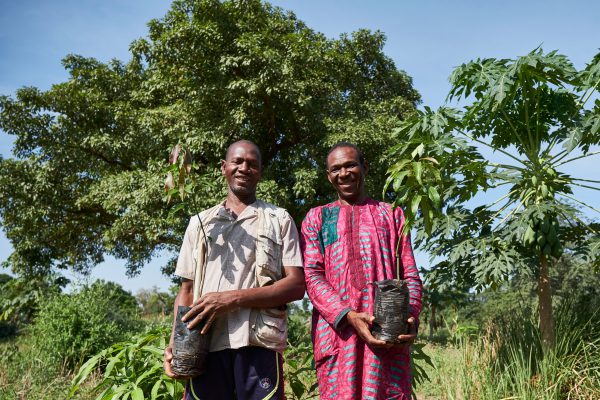This year, leverage your workspace strategy to help fight deforestation and remove carbon pollution from the atmosphere.
When Upflex’s cofounders set out to start something new, they knew they wanted to make work better, not just for the workforce, but for the planet itself.
“We started looking at the industry and we thought, there’s so much waste — it’s just unbelievable,” my fellow cofounder and chief product officer Ginger Dhaliwal said in a recent interview. “Something like 40% of office space — coworking, corporate offices — is underutilized every single day, and we continue to build more space, which is harming the environment, only to continue to be underutilized.”
As company leaders, we have a responsibility to help address these inefficiencies — and to offset our impact.
Upflex’s technology allows companies to easily give their teams access to a global network of workspaces across more than 80 countries, so workers can choose workspaces that are conducive to productivity but close to home, shaving off commutes and cutting back on companies’ need to keep paying for unnecessary real estate. This is part of how we’re building sustainability into the future of work. We didn’t stop there: We are also partnered with nonprofit Trees for the Future, so every time a user books a workspace with Upflex, a new tree is planted.
When you use Upflex for your team, they can share in the accomplishment. As your team books desks, new trees are taking root.
If the planet isn’t your top priority, know a sustainable approach is a benefit to your business, too: Study after study shows that millennial and Gen Z talent cares deeply about sustainability, fighting climate change, and reducing their environmental impact in all aspects of life, from the surging popularity of “green” products to a whole new outlook on air travel. That priority will keep manifesting in the workplace, informing how we as leaders hire, how we manage, and how we operate our businesses overall — not to mention what talent we have access to and how long they stick around.
Trees for the future
Planting a single tree may seem like a tiny gesture — but what if that one tree is just the beginning? That’s the idea behind campaigns by environmental activists to plant a trillion trees in a low-cost effort to remove CO2 from the atmosphere. Trees, even compared to more sophisticated man-made carbon-removal technology, are incredibly effective at absorbing carbon — up to 7.6 billion metric tons per year. So planting more, paired with reducing carbon emissions, seems like a surefire way to help slow climate change.
Yishan Wong, former CEO of Reddit, is one champion of this worldwide movement. In 2019, he founded Terraformation, aimed at reforestation: “A trillion trees has a very, very strong possibility of solving the [climate] problem,” Wong said. He noted that it’s easy and affordable enough to be replicated around the world: “You want the simplest, most affordable solution because it will operate at enormous scale.” In these past few years, trillion-tree campaigns, including one by the World Economic Forum, have sprouted all over the globe as a ray of hope when it comes to solving for climate change.
Some scientists have quibbled with the approach, arguing the carbon-absorbing potential of trees is insufficient — it’s too late for trees to undo damage done — or that there isn’t enough undeveloped land left on Earth to host a trillion new trees. But even if reforestation alone isn’t enough to combat climate change, it is certainly part of a solution. Even a vocal critic of the effort, Joseph Veldman of Texas A&M University, noted that “there is a small but important role that forests can play in mitigating climate change.”
We believe in the power of planting trees to help foster a healthier atmosphere — on top of cutting back on construction of new commercial office buildings, ceasing to spend valuable energy on half-empty office buildings, and eliminating or greatly reducing gas-guzzling commutes to the workplace.
Tens of thousands of trees planted
With the help of our community, and our partners at Trees for the Future, we’ve now planted many thousands of trees so far. With every million trees planted, we absorb approximately 24,000 tons of CO2 ever year, helping to stabilize climate-affected ecosystems and reduce the effects of climate change.
The benefits don’t stop with carbon offset: Trees fight deforestation; they produce fruits and vegetables farmers can trade, sell, and put on their own tables; and according to Trees for the Future, they increase rural farmers’ potential income by an average of 400% in places like Cameroon, Kenya, Senegal, Uganda, Guinea and Tanzania where the program operates.
From where I sit, there are few greener things a company can do than support an initiative like planting trees, and if you’re a leader aspiring to achieve net-zero emissions, this is a must.

Farmers in their forest garden project by Trees for the Future on November 17, 2018 in Kedougoou, Senegal. Photo: Xaume Olleros for Trees for the Future
With every passing week, more companies, in more places, are instituting permanent remote or hybrid work policies. With the right thoughtfulness, planning and data, they can harvest the sustainability benefits of these strategies — and make those benefits clear to their clients, teams and prospective hires. Sustainable companies will be the ones that stay relevant, and win talent.
And fortunately, as remote work adoption grows, such solutions are only growing easier for leaders to implement.


